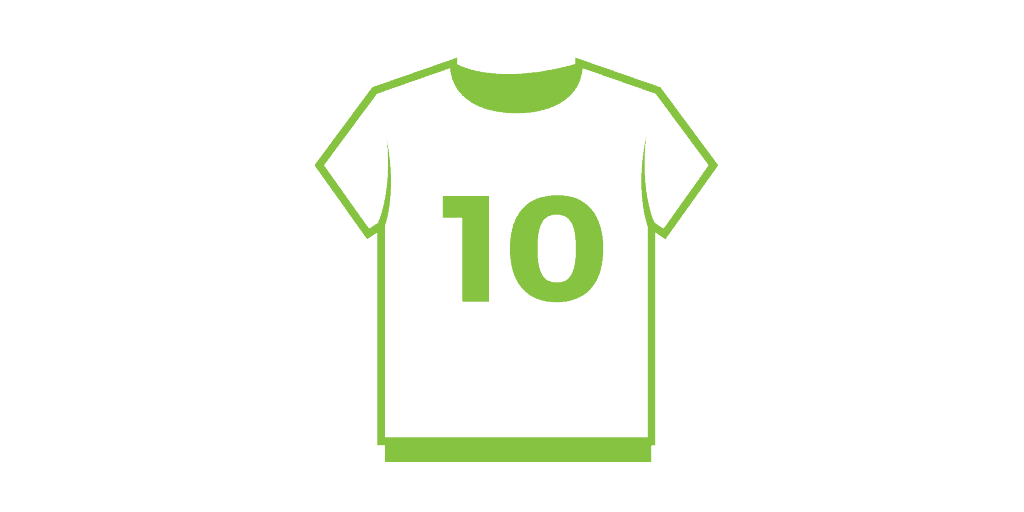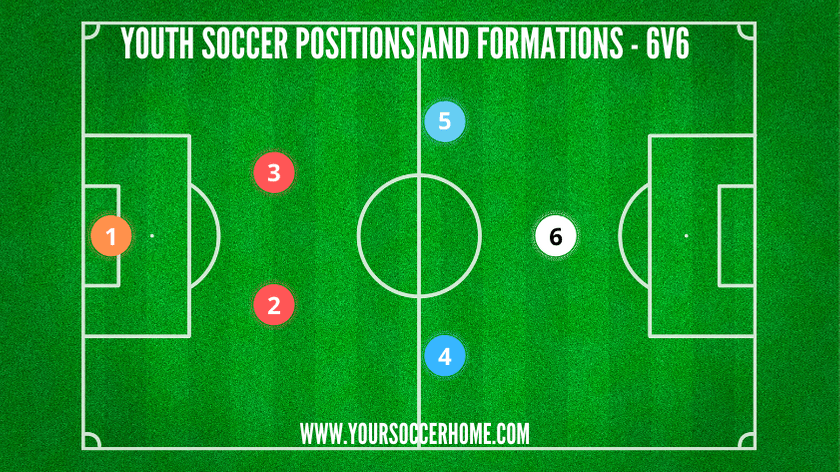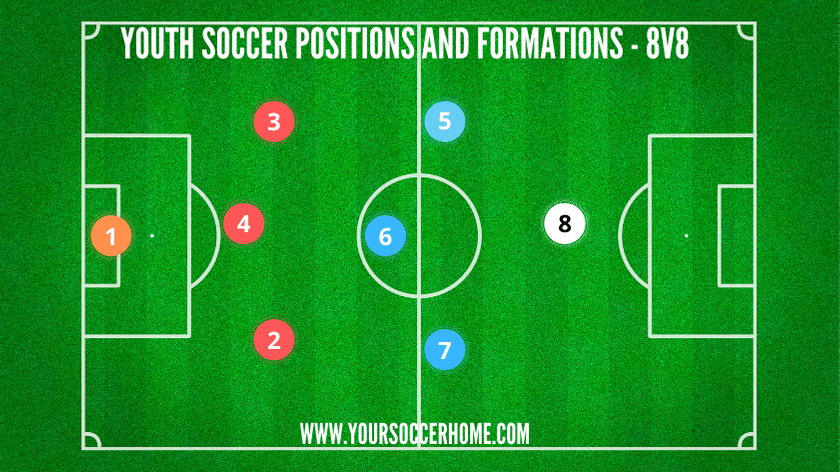Welcome to the Ultimate Guide to Youth
Over the years, I’ve seen many youth
I have found that an understanding of how and where the players are positioned on the field has increased my enjoyment of the game, and in this article, I want to share what I’ve learned with you.
But for those of you wanting to understand more about youth
Youth
- Goalkeeper (GK)
- Right Back (RB)
- Left Back (LB)
- Right Side Center Back (RCB)
- Left Side Center Back (LCB)
- Defensive Midfielder (DM)
- Right Midfielder/Winger (RM)
- Central Midfielder (CM)
- Striker/Center Forward (S/CF)
- Attacking Midfielder/Playmaker (AM)
- Left Midfielder/Winger (LM)
Soccer Positions: Complete Guide
These positions used in youth
At a professional level, there are eleven players on a
Throughout this article, we’ll look at the player’s positions in youth
But first, let’s quickly look at how the positions on the
The Number on the Soccer Jersey Relates to the Position

As you watch
As shown in the list of
The interesting thing is that within the rules of
wear any specific number at all. (Although they do have to display a unique number so the referee can easily identify them.)
Because of this, as you watch a game, you may see a player playing in defense wearing a number 8 or a player playing in midfield wearing a number 32.
The reality is that the actual number displayed on a jersey does not have as much importance in modern
On a side note, if you’re looking to purchase a new
check out the range at
It’s important to know that the numbers used at the start of this article relate to a game where each team is fielding 11 players. Yet, because of the nature of youth
each team.
Youth players often don’t have the capacity to run for as long or as far as older players. And to compensate for this, the field they play on is often considerably smaller than a full-size field, and the game time considerably
shorter.
The number of players most commonly used in a youth
Despite the limited capacity of youth players, and an example of how skilled and exciting to watch a youth
Soccer Positions Create Formations

You also can’t talk about
In
For example, in an 11-a-side
To clarify this, let me explain this a bit further…
The numbers in a formation start from defense and work their way forward through the midfield, and end with the forwards.
In the example of the formation “4-4-2”, the first number 4 refers to the group of defenders, the second number 4 refers to the midfielders, and the
last number, the number 2, refers to the forwards.
Each number indicates how many players are playing in that position on the field.
Again using the 4-4-2 example, this means that there would be 4 players in defense, 4 players in midfield, and 2 playing offense. In a 4-3-3 formation, there would be
4 players in defense, 3 in midfield, and three players positioned in the offense.
You may have also noticed that whenever formations are listed, there is always one number less than the total amount of players on a team. The reason for this is that the goalie is never included in the number in
formations.
Instead of putting a number “1” in front of every single formation, it is simply assumed that a goalie is on the field as part of the team.
This can be safely assumed because, in
the team at any time, and they always play in the position directly in front of the goal.
If you want to know more about the requirements for a
Youth Soccer Positions: Including Diagrams and Formations
Now we’ve established what the position numbers on a player’s jersey refer to and how formations are a key part of understanding
As mentioned above, in youth
At a professional level, there are eleven positions in
soccer . These positions cover thesoccer field from the front to the back. In youthsoccer , there may be 6, 7, 8, or 9 positions depending on the age of the players in the game.
Below you will find positions, numbers, player roles, and formations for games of 6v6, 7v7, 8v8, 9v9, and 11v11.
Youth soccer positions: 6v6

Goalie – Orange / Defenders – Red / Midfielders – Blue / Forwards – White
In a 6v6 youth
As you can see in the image above, the players are positioned with two in defense, two in midfield, and one in the offense.
These positions on the field allow the team to maintain a strong defense and midfield while still having a focal point for the offense.
Although in a 6v6
6v6 youth soccer positions and numbers
The positions and numbers for the players in a 6v6 youth
- Goalkeeper
- Right side defender
- Left side defender
- Right-side midfielder
- Left side midfielder
- Striker
Youth soccer positions: 7v7

Goalie – Orange / Defenders – Red / Midfielders – Blue / Forwards – White
The recommendation for the U9 and U10 age groups is that they play in
The most popular setup for a 7v7
As you can see in the image above, players are positioned with two players in defense, three in midfield, and one striker.
With the players in these positions, the midfield is the strongest part of the team. This is important as the center of the field is where most of the action happens.
Having three players in midfield gives the team enough numbers to drop back, support the defense when needed, and move forward and support the offense as needed.
7v7 youth soccer positions and numbers
The positions and numbers for the players in a 7v7 youth
- Goalkeeper
- Right side defender
- Left side defender
- Central midfielder
- Left side midfielder
- Right side midfielder
- Striker
For more 7v7 formation options, check out my article – 7v7 Soccer Formations: A Complete Guide
Youth soccer positions: 8v8

Goalie – Orange / Defenders – Red / Midfielders – Blue / Forwards – White
In a youth
This formation has three defensive players, three midfield players, and one striker.
In this formation, the team has a strong defensive foundation and a strong midfield. The numbers of players in both these areas provide enough cover for the team when the ball is in that part of the field.
Having the players in these positions allows them to move forward and back to support the defensive or offense as needed.
A defender or midfielder can move forward to support the team and still leave two players covering behind them, or a midfielder can move back to support the defense and confidently leave two players positioned in midfield covering there
if needed.
8v8 youth soccer positions and numbers
The positions and numbers for the players in an 8v8 youth
- Goalkeeper
- Right side defender
- Left side defender
- Central defender
- Left side midfielder
- Central midfielder
- Right side midfielder
- Striker
Youth soccer positions: 9v9

Goalie – Orange / Defenders – Red / Midfielders – Blue / Forwards – White
The recommendation for the under 11 and under 12 age groups is that they play
In a
Three players on defense, three in midfield, and two players playing offense.
Having nine players on the field means there are now enough players to play two in the offense position rather than only one while maintaining the strength of the defensive and midfield.
Having this extra player in an offensive position also means the team has an extra player in a position to score when the opportunity comes up. And every team hopes that this extra player translates into more goals!
9v9 youth soccer positions and numbers
The positions and numbers for the players in a 9v9 youth
- Goalkeeper
- Right side defender
- Left side defender
- Central defender
- Left side midfielder
- Central midfielder
- Right side midfielder
- Center forward
- Striker/playmaker
Youth soccer positions: 11v11

Once a youth
In 11v11
This formation has four players on defense, 4 in the midfield, and two up front.
Having the players in these positions provides a strong line of defense and midfield. The players can quickly cover all the areas and move forward and back as needed.
It also allows for two players in the main attacking positions. Often one of these players will play slightly further back than the other. Positioned just in front of the midfield, they act as a playmaker and a link between the midfield
and forwards.
11v11 youth soccer positions and numbers
The positions and numbers for the players in a 11v11 youth
- Goalkeeper
- Right back
- Left-back
- Right side Center Back
- Left side Center Back
- Defensive Midfielder
- Right Midfielder/Winger
- Central Midfielder
- Striker/Center forward
- Playmaker
- Left Midfielder/Winger
Soccer Ball Size Guide: Choose the right size ball
Conclusion and Recommendations
Hopefully, this article has helped you understand the players’ positions in youth
If you, or someone you know, are looking to dramatically improve your
